L'acier inoxydable duplex fait référence à un matériau dont la microstructure est composée de ferrite et d'austénite, chacune représentant environ 50%. Dans une utilisation réelle, il est plus approprié que l'une des phases soit comprise entre 40 et 60%.
Selon les caractéristiques de la structure en deux phases, en contrôlant correctement la composition chimique et le processus de traitement thermique, l'excellente ténacité et la soudabilité de l'acier inoxydable austénitique sont combinées avec la résistance plus résistante et la résistance à la corrosion des contraintes de chlorure de l'acier inoxydable ferritique, un traitement inoxydable duplex un type d'acier qui combine une excellente résistance à la corrosion, à la haute résistance et à une transformation facile et à la fabrication. Leurs propriétés physiques se situent entre l'acier inoxydable austénitique et l'acier inoxydable ferritique, mais plus proche de l'acier inoxydable ferritique et de l'acier au carbone. La résistance aux piqûres de chlorure et la corrosion des crevasses de l'acier inoxydable duplex est liée à la teneur en chrome, en molybdène et en azote. Sa résistance aux piqûres et à la corrosion des crevasses peut être similaire à celle de 316 en acier inoxydable, ou supérieure à celle de l'acier inoxydable pour l'eau de mer, comme en acier inoxydable à 6% Mo austénitique. Tous les aciers inoxydables duplex sont nettement plus résistants à la fissuration de la corrosion des contraintes de chlorure que les aciers inoxydables austénitiques de la série 300, et leur force est également beaucoup plus élevée que les aciers inoxydables austénitiques, tout en montrant une bonne plasticité et une bonne ténacité.
Diverses formes de produits en acier inoxydable duplex: plaques et bandes tuyaux - tuyaux affinés et tuyaux sans couture
L'acier inoxydable duplex peut généralement être divisé en quatre catégories:
Un: type à faible alliage, grade représentatif UNSS32304, l'acier ne contient pas de molybdène, Pren: 24-25, peut remplacer l'AISI 304 ou 316 en termes de résistance à la corrosion des contraintes.
Deux: type d'alliage moyen, grade représentatif UNSS31803, Pren: 32-33, la résistance à la corrosion se situe entre AISI316L et 6% Mo + N en acier inoxydable austénitique.
Trois: le type d'alliage élevé, contenant généralement 25% de Cr, contient également du molybdène et de l'azote, certains contiennent également du cuivre et du tungstène, les grades standard sont UNS32550, Pren: 38-39, la résistance à la corrosion est supérieure à l'acier inoxydable duplex 2% Cr.
Quatre: type en acier inoxydable super duplex, contenant un molybdène élevé et de l'azote, les grades standard sont UNSS32750, certains contiennent également du tungstène et du cuivre, Pren> 40, peuvent être utilisés dans des conditions moyennes difficiles, avec une bonne résistance à la corrosion et des propriétés mécaniques complets, comparables à l'acier inoxydable super austénitique. (Remarque: Pren: valeur équivalente de résistance aux piqûres)
Composition chimique Les principaux éléments d'alliage de l'acier duplex sont Cr, Ni, Mo et N. Parmi lesquels, Cr et Mo sont utilisés pour augmenter la teneur en ferrite, tandis que Ni et N sont des éléments stabilisants de l'austénite. Certains niveaux d'acier ont également des éléments tels que Mn, Cu et W. Cr, Ni et Mo peuvent améliorer la résistance à la corrosion. Sa résistance aux piqûres et à la corrosion des crevasses est particulièrement bonne dans les environnements contenant du chlorure.
Avantages de l'acier inoxydable duplex
1. Comparé à l'acier inoxydable austénitique
1) La limite d'élasticité est plus du double de celle de l'acier inoxydable austénitique ordinaire, et il a une plasticité et une ténacité suffisantes nécessaires à la formation. L'épaisseur des réservoirs de stockage ou des récipients sous pression en acier inoxydable duplex est de 30 à 50% de moins que celle de l'acier inoxydable austénitique couramment utilisé, ce qui est propice à la réduction des coûts.
2) Il a une excellente résistance à la fissuration de la corrosion de contrainte, en particulier dans les environnements contenant des ions de chlorure. Même l'acier inoxydable duplex avec la plus faible teneur en alliages a une résistance plus élevée à la fissuration de la corrosion de contrainte que l'acier inoxydable austénitique. La corrosion du stress est un problème important que l'acier inoxydable austénitique ordinaire est difficile à résoudre. 3) La résistance à la corrosion de l'acier inoxydable duplex 2205 le plus courant utilisé dans de nombreux milieux est meilleure que celle de l'acier inoxydable austénitique 316L ordinaire, et l'acier inoxydable super duplex a une résistance à la corrosion extrêmement élevée. Dans certains milieux, tels que l'acide acétique et l'acide formique, il peut même remplacer l'acier inoxydable austénitique à haut alliage et même les alliages résistants à la corrosion. 4) Il a une bonne résistance à la corrosion locale. Par rapport à l'acier inoxydable austénitique avec la même teneur en alliage, sa résistance à la corrosion d'usure et sa résistance à la fatigue de la corrosion sont meilleures que l'acier inoxydable austénitique. 5) Le coefficient d'extension linéaire est inférieur à celui de l'acier inoxydable austénitique, près de celui de l'acier au carbone, adapté à la connexion avec l'acier au carbone, et a une importance d'ingénierie importante, telle que la production de plaques ou de revêtements composites.
2. Comparé à l'acier inoxydable ferritique, les avantages de l'acier inoxydable duplex sont les suivants:
1) Les propriétés mécaniques complètes sont plus élevées que celles de l'acier inoxydable ferritique, en particulier la ténacité en plastique. Il n'est pas aussi sensible à la fragilité que l'acier inoxydable ferritique.
2) À l'exception de la résistance à la corrosion des contraintes, les autres résistances locales de corrosion sont meilleures que l'acier inoxydable ferritique.
3) Les performances de traitement du froid et les performances de formage à froid sont bien meilleures que l'acier inoxydable ferritique.
4) Les performances de soudage sont bien meilleures que l'acier inoxydable ferritique. Généralement, aucune préchauffage n'est requise avant le soudage et aucun traitement thermique n'est requis après le soudage.
5) La plage d'application est plus large que celle de l'acier inoxydable ferritique.
Application
En raison de la forte résistance de l'acier duplex, il peut souvent économiser des matériaux, tels que la réduction de l'épaisseur de la paroi du tuyau. Prenez SAF2205 et SAF2507W comme exemples. SAF2205 convient à une utilisation dans des environnements contenant du chlore. Ce matériau convient au raffinage d'huile ou à d'autres milieux de processus mélangés à des chlorures. SAF2205 convient particulièrement aux échangeurs de chaleur qui utilisent des solutions aqueuses contenant du chlore ou une eau légèrement salée comme support de refroidissement. Ce matériau convient également aux solutions d'acide sulfurique diluées et aux acides organiques purs et à leurs mélanges. Par exemple: tuyaux de pétrole dans l'industrie du pétrole et du gaz: dessalement du pétrole brut dans les raffineries, purification des gaz contenant du soufre, équipement de traitement des eaux usées; Systèmes de refroidissement utilisant des solutions d'eau légèrement salées ou contenant du chlore.
Heure du poste: février-05-2025

